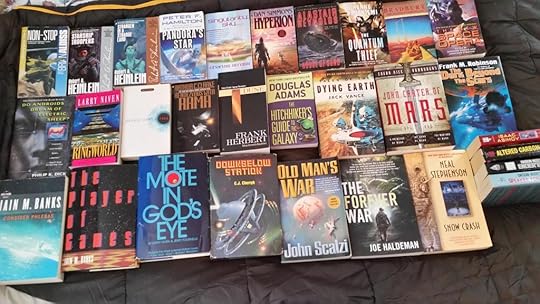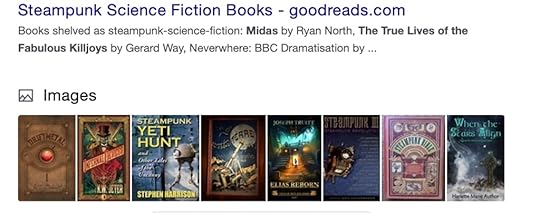Exploring Science Fiction Genres: Hard/Soft, Dystopian/Utopian, Space Opera
WHAT DEFINES SCIENCE FICTION?

Science fiction or speculative fiction (often shortened to SF, sci-fi or scifi) is a genre dealing with futuristic science, technology, space travel, time travel, faster than light travel, parallel universes, and extraterrestrial life. Science fiction often explores the potential outcomes of scientific innovations, and has been referred a “literature of ideas,” or future-casting. It usually avoids the supernatural, and unlike the related genre of fantasy, science fiction stories generally deal in plots and stories grounded in by some form of widely accepted scientific fact. Star Trek is based on the premise that man will discover a way to conquer light speed, or access parallel dimensions.
Hard/Soft Science Fiction: is a category of science fiction marked by an emphasis on scientific accuracy. The terms were first used in print in 1957 by P. Schuyler Miller in a review of John W. Campbell, Jr.’s “Islands of Space” in Astounding Science Fiction. The complementary term Soft Science Fiction, formed by comparison to hard science fiction, first appeared in the late 1970s. It was created to emphasize the distinction between the “hard” (natural) and “soft” (social) sciences. Science fiction critic Gary Westfahl thinks that both terms are just ways of describing stories that reviewers and commentators have found useful.
Dystopian/Utopian: utopia and its derivative, dystopia, are genres exploring social and political structures. Utopian fiction shows a setting agreeing with the author’s ideology and has attributes of different reality to appeal to readers. Dystopian (or dystopic) fiction (sometimes combined with, but distinct from apocalyptic literature) is the opposite. It shows a setting that completely disagrees with the author’s ideology. Many novels combine both, often as a metaphor for the different directions’ humanity can take, depending on its choices. Both utopias and dystopias are commonly found in science fiction and other speculative fiction genres and arguably are a type of speculative fiction. Dystopian and Post-Apocalyptic are two sub-genres of Science Fiction although you will often find them mixed into the same stories.
Dystopia is the opposite of Utopia. If Utopia is an ideal society, then dystopia is the opposite, or a flawed utopia depending on semantics. Of course, this depends on what the writer’s concept of the ideal society. I agree the description is vague. This is what makes the genre so much fun to write and read. As a genre, dystopian crosses a lot of other sub-science fiction genres as well. The Hunger Games (2008) brought the genre to fore again, but contrary to popular belief the genre has been around a long time.1
Dystopian novels often focus on societies and cultures that appear stable and well established. The post-apocalyptic genre with which it is often mixed, usually depicts an imbalanced or volatile cultures (Mad Max).
Common Themes in Dystopian Fiction: Poverty, Technology being abused, Oppressive social institutions, abuse of power by governments, etc.
Post-Apocalyptic Science Fiction is a sub-genre of Dystopian Science Fiction covering the end of civilization, through nuclear war, plague, or some other general disaster. Post-apocalyptic stories are most often set in the aftermath of the collapse of civilization or society as we know it. Man’s attempt to regain control of his environment after an apocalypse is fertile ground for creating a totalitarian/dystopian society. Common themes in post-apocalyptic literature are loss of resources, global natural disasters including storms, earthquakes, rising oceans, pandemics, loss of technology, widespread radiation, etc.
This sub-genre has been around a long time. In 1826 Mary W. Shelley (Frankenstein’s Monster) wrote The Last Man (a plague kills off most of the population).
The time frame may be immediately after the catastrophe, focusing on the travails or psychology of survivors, or considerably later, often including the theme that the existence of pre-catastrophe civilization has been forgotten or mythologized. Post apocalyptic stories often take place in an agrarian, non-technological future world, or a world where only scattered elements of technology remain. FYI there is a third genre associated with these two: An apocalyptic novel tells the story of the end of the world, which occurs during the timeline of the story.
Space Opera: is a subgenre of science fiction emphasizing space warfare, melodramatic adventure, interplanetary battles, risk-taking, and chivalric romance. Set mainly or entirely in outer space, it frequently involves conflict between opponents possessing advanced abilities, futuristic weapons, and other sophisticated technology. The term has no relation to music but was coined during the 1930s to indicate clichéd and overused stories in several genres. Space operas emerged in the 1930s and they continue to be produced in literature, film, comics, and video games. The most notable was probably produced by E.E. “Doc” Smith in the 1930’s.
What is Steampunk Science Fiction?
Not to be confused with Cyberpunk Fiction. This genre uses steampower to create some of the same technology we use today through other means. Computers, robots, airships, radios, and communication devices, etc. The steam may be created by use of burning coal or in some cases by a chemical reaction induced by combining two incompatible elements.
 Screenshot
ScreenshotSteampunk: is a hybrid subgenre of science fiction or science fantasy that refers to works set in an era where steam power is still widely used;19th century’s British Victorian era or American “Wild West, where steam power has maintained mainstream usage, or in a fantasy world that employs steam power in the same way. Although its literary origins are sometimes identified with the cyberpunk genre, it has marked differences. Inventions like those found in the works of H. G. Wells and Jules Verne are often included. Steampunk encompasses alternate history-style elements of past technology like dirigibles or mechanical computers combined with futuristic technology like multi-function goggles, giant robots and ray guns. Steampunk may be described as neo-Victorian. Steampunk most recognizably features anachronistic technologies or retro futuristic inventions as people in the 19th century might have envisioned them, and is likewise rooted in the era’s perspective on fashion, culture, architectural style, and art.
Cyberpunk: Cyberpunk is a subgenre of science fiction taking place in a future setting. It tends to focus on society as “high tech low life” showcasing advanced technological and scientific accomplishments, such as information technology and cybernetics, creating a breakdown or radical change in the social order. Cyberpunk plots often center on conflict among artificial intelligences, hackers, and megacorporation’s in a near-future Earth. The settings are usually post-industrial dystopias but feature extraordinary cultural turmoil and the use of technology in ways never anticipated by its original inventors. Much of the genre’s atmosphere echoes film noir writers and often uses modus operandi from this genre of detective fiction. The genre often features countercultural antiheroes trapped in a dehumanizing high-tech future with primary themes of hyper-corporatism, online intrigue, virtual reality. Sometimes it includes a black-market underground. Its roots extend back to the technical fiction of the 1940s and ’50s, but it was years before it matured. The word cyberpunk was coined by writer Bruce Bethke, who wrote a story with that title in 1980. It is usually based in a dystopian setting with futuristic elements such as artificial intelligence juxtaposed with the collapse or decay of existing society.
Military Science Fiction: is a subgenre of science fiction that uses science fiction technology, mainly weapons, for military purposes. Its principal characters are generally members of a military organization involved in military activity. The action sometimes takes place in outer space or on a different planet or planets. It is found in literature, comics, film, and video games. A detailed description of the conflict, the tactics and weapons used, and the role of a military service and the individual members of that military organization generally forms the basis for a work of military science fiction. The stories often use events of actual past or current Earth conflicts, with countries being replaced by planets or galaxies of similar characteristics, battleships replaced by space battleships and certain events changed so that the author can induce what might have occurred differently.
Alternate History: or alternative history (British English), sometimes abbreviated as AH, is a genre of stories in which one or more historical events occur differently than as history recorded them. These stories are set in a world in which history has deviated from history as it is generally known; more simply put, alternate history asks the question, “What if history had developed differently?” Most works in this genre are set in real historical contexts, yet feature social, geopolitical, or industrial settings that developed differently or at a different pace from our own. This subgenre comprises fiction in which a change or point of divergence happens that causes history to diverge from our own.
Steampunk: This genre uses steampower to create some of the same technology we use today through other means. Computers, robots, airships, radios, and communication devices, etc. The steam may be created by use of burning coal or in some cases by a chemical reaction induced by combining two incompatible elements.
It is a subgenre of science fiction or science fantasy that refers to works set in an era where steam power is still widely used;19th century’s British Victorian era or American “Wild West, where steam power has maintained mainstream usage, or in a fantasy world that employs steam power in the same way. Although its literary origins are sometimes identified with the cyberpunk genre, it has marked differences. Inventions like those found in the works of H. G. Wells and Jules Verne are often included. Steampunk encompasses alternate history-style elements of past technology like dirigibles or mechanical computers combined with futuristic technology like multi-function goggles, giant robots, and ray guns. Steampunk may be described as neo-Victorian. It most recognizably features anachronistic technologies or retro futuristic inventions as people in the 19th century might have envisioned them, and is likewise rooted in the era’s perspective on fashion, culture, architectural style, and art.
Clockpunk: Steampunk has developed several sub-genres of its own. The most common is Clockpunk. Clockpunk is similar in but rather than focusing on steam driven mechanisms, it focuses on devices that rely on energy stored in springs, using clockwork technology. Science Fiction or fantasy stories using technology primarily relying on wound springs for power can fall under this genre. If the technology involved in the story relies on a secondary source for power, say nuclear, it would remain in the clockpunk genre. Springs do wind down and must be rewound by some means, even if it is something as mundane as human muscle. So, as conceived, clockwork technology relies upon at least one other source of power to wind its gears.
Gaslight Fiction This genre uses steampower to create some of the same technology we use today through other means. It is a subgenre of science fiction or science fantasy that sometimes refers to works set in an era where steam power is still widely used. It differs from pure Steampunk in that the stories have less super-science and are less often associated with alternate timelines.
Gaslamp Fantasy, another sub-genre of Steampunk, also known as Gaslight Romance, taking place in the Victorian era. This realm of fantasy employs either a Victorian or Edwardian setting. It differs from pure Steampunk in that the stories have less super-science and are less often associated with alternate timelines.Romantic Science Fiction: This genre seems to be written almost exclusively for and by women. In many cases, it is simply a love story set in the future or a distant planet. It differs from Sci-Fi Romance in that in many cases the love interest is an alien. These books are easily spotted because their covers most often feature half-naked male figures. These figures sometimes have horns and different skin colors in blue, green or sometimes even purple. They also feature plots very similar to some of the old bodice rippers popular in the 1960s and 1970s, where the woman is captured and then falls in love with the man who captured her. In the Sci Fi genre, the bodice ripper heroes seem to have been replaced by hunky looking aliens who kidnap human women as ‘mates’. If you want to learn more about this category, I can recommend https://www.sfrstation.com



